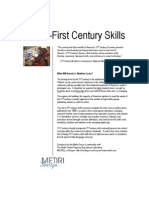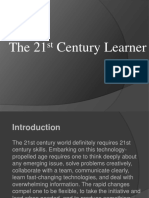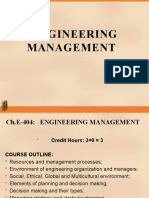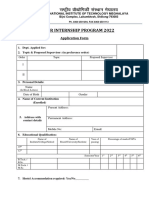Reviewer TNCT 1st QRTR
Reviewer TNCT 1st QRTR
Uploaded by
Rachelle Anne SaldeCopyright:
Available Formats
Reviewer TNCT 1st QRTR
Reviewer TNCT 1st QRTR
Uploaded by
Rachelle Anne SaldeOriginal Title
Copyright
Available Formats
Share this document
Did you find this document useful?
Is this content inappropriate?
Copyright:
Available Formats
Reviewer TNCT 1st QRTR
Reviewer TNCT 1st QRTR
Uploaded by
Rachelle Anne SaldeCopyright:
Available Formats
Trends, Networks and Critical thinking in LATEST 21ST CENTURY SKILLS:
the21st century
LEARNING SKILLS- teaches students about the
ST
21 CENTURY SKILLS mental processes required to adapt and
improve upon a modern work environment.
THE FIRST SET OF 21ST CENTURY SKILLS BY
4 C's
SIEMENS:
Critical thinking- finding solutions to problems.
ANCHORING: Staying focused on important
tasks while undergoing a deluge of distractions. Creativity- thinking outside the box.
FILTERING: Managing knowledge flow and Collaboration- working with others.
extracting important elements.
Communication- talking to others.
CONNECTING WITH EACH OTHER: Building
networks in order to continue to stay current LITERACY SKILLS- focuses on how students can
and informed. discern facts, publishing outlets, and the
technology behind them.
BEING HUMAN TOGETHER: Interacting at a
human, not only utilitarian, level to form social Information literacy: Understanding facts,
spaces figures, statistics, and data.
CREATING AND DERIVING MEANING: Media literacy: Understanding the methods
Understanding implications, comprehending and outlets in which information is published.
meaning and impact.
Technology literacy: Understanding the
EVALUATION AND AUTHENTICATION: machines that make the Information Age
Determining the value of knowledge and possible
ensuring authenticity.
LIFE SKILLS is the final category. Also called
ALTERED PROCESSES OF VALIDATION: FLIPS, these skills all pertain to someone’s
Validating people and ideas within appropriate personal life, but they also bleed into
context. professional settings.
CRITICAL AND CREATIVE THINKING: Employing Flexibility: Deviating from plans as needed.
standards of thinking, knowing the box before
Leadership: Motivating a team to accomplish a
going outside the box.
goal.
PATTERN RECOGNITION: Decision-making
Initiative: Starting projects, strategies, and
process in defining a problem.
plans on one’s own
NAVIGATION OF THE KNOWLEDGE
Productivity: Maintaining efficiency in an age of
LANDSCAPE: Navigating between repositories,
distractions
people, technology and ideas while achieving
intended purposes. Social skills: Meeting and networking with
others for mutual benefit.
ACCEPTANCE OF UNCERTAINTY: Balancing
what is known with the unknown to see how
existing knowledge relates to what we do not
know.
CONTEXTUALIZING: Careful consideration of
the situation.
TRENDS AND FADS
•Technological Factors include ecological and
TREND is a gradual change or development that environmental aspects, such as R&D
produces a particular result. activity, automation, technology incentives and
the rate of technological change.
FAD is something, such as an interest or
fashion, that is very popular for a short time.
ELEMENTS OF A TREND: SWOT ANALYSIS is a situational analysis tool for
company leaders that involves assessing
1.Duration of Time strengths, weaknesses, opportunities and
2.Acceptability threats.
3.Cultural Basis
4.Transitory Increase or Decrease Good luck!
--------------------------END---------------------------
NEURAL NETWORKS Prepared by: mcsb
TYPES OF THINKING:
INTUITIVE THINKING is "quick and ready
insight". It means having the ability to
understand or know something without any
direct evidence or reasoning process.
STRATEGIC THINKING is the process of
conducting research on the business
environment within which an organization itself
in order to formulate strategy.
Tools Of Strategic Analysis:
PEST ANALYSIS describes a framework of macro
environmental factors used in the
environmental scanning component of strategic
management.
•Political Factors are how and to what degree a
government intervenes in the economy.
•Economic Factors include economic growth,
interest rates, exchange rates and the inflation
rate.
•Social Factors include the cultural aspects and
include health consciousness, population
growth rate, age distribution, career attitudes
and emphasis on safety.
You might also like
- Guidelines in Instructional AidsDocument32 pagesGuidelines in Instructional AidsDepEdResources100% (5)
- Skilla Transversal Skills Future ProofDocument48 pagesSkilla Transversal Skills Future ProofJoanna MarieNo ratings yet
- A Report of Training and Development Process of Brac Bank LimitedDocument64 pagesA Report of Training and Development Process of Brac Bank LimitedShaon Hossen100% (3)
- Reviewer TNCT 1st QRTRDocument2 pagesReviewer TNCT 1st QRTRRachelle Anne SaldeNo ratings yet
- 21st Century Skills Categories-Group2finalDocument42 pages21st Century Skills Categories-Group2finalGLENDMARC BALANSAGNo ratings yet
- Global Awareness Financial, Economic, Business and Entrepreneurial Literacy Civic Literacy Health LiteracyDocument6 pagesGlobal Awareness Financial, Economic, Business and Entrepreneurial Literacy Civic Literacy Health LiteracyMICHAEL JIMENONo ratings yet
- Knowledge Management: G. Amirthraj Mba-Ii Year Manakula Vinayagar Institute of Technology Mobile No 9629321360Document8 pagesKnowledge Management: G. Amirthraj Mba-Ii Year Manakula Vinayagar Institute of Technology Mobile No 9629321360ganapathyNo ratings yet
- Ped 110x BallesterDocument64 pagesPed 110x BallesterNistan jen SolanoNo ratings yet
- DI - Global Human Capital Trends 2024 53 66Document14 pagesDI - Global Human Capital Trends 2024 53 66adibuana.surya.6No ratings yet
- 21st Century SkillDocument27 pages21st Century SkillSteben MeuerteNo ratings yet
- SSTNCTC CM1Document12 pagesSSTNCTC CM1pukimosesNo ratings yet
- ELEM 1413 Technology For Teaching and Learning in The Elementary GradesDocument9 pagesELEM 1413 Technology For Teaching and Learning in The Elementary GradesAngellete GopezNo ratings yet
- Robot Proof: Higher Ed. in The Age of Artificial IntelligenceDocument3 pagesRobot Proof: Higher Ed. in The Age of Artificial IntelligenceJohnJachersonNo ratings yet
- The 21st Century SkillsDocument20 pagesThe 21st Century SkillsPablo Bulac AtacadorNo ratings yet
- EDTECHDocument3 pagesEDTECHJannica Dinglasa VisitacionNo ratings yet
- Tech CrtImergTecDocument4 pagesTech CrtImergTecyfmrbxgw6jNo ratings yet
- Part 2.2and 2.3 Sample Intra - Multi - and Inter - Disciplinary PTsDocument7 pagesPart 2.2and 2.3 Sample Intra - Multi - and Inter - Disciplinary PTsKimberlyn Mae Forro AlveroNo ratings yet
- HRDL - Session 3 - Global Leadership Competencies-2Document32 pagesHRDL - Session 3 - Global Leadership Competencies-2oketch91daveNo ratings yet
- BUNINGDocument20 pagesBUNINGpaulamhae.taruc.sNo ratings yet
- GROUP 1 2nd PartDocument30 pagesGROUP 1 2nd PartsitoygysylmNo ratings yet
- Chapter 4 FinalizedDocument24 pagesChapter 4 FinalizedMyca HernandezNo ratings yet
- Bsa 1 2 Copy - Entrep Chap 5Document6 pagesBsa 1 2 Copy - Entrep Chap 5Dela Cruz, Reine Angelo D.No ratings yet
- Se 105 - Career Readiness - Guide To A New World of WorkDocument31 pagesSe 105 - Career Readiness - Guide To A New World of WorkJobeline EnrileNo ratings yet
- 21st Century Skills Categories-Group2Document8 pages21st Century Skills Categories-Group2GLENDMARC BALANSAGNo ratings yet
- Group 2 21ST Century Skills Categories - 20240926 - 010110 - 0000Document43 pagesGroup 2 21ST Century Skills Categories - 20240926 - 010110 - 0000markjosephcalipes15No ratings yet
- What Are 21st Century Skills - Setia Dwi AnjaniDocument9 pagesWhat Are 21st Century Skills - Setia Dwi AnjaniAnjaniNo ratings yet
- Rosete EdTech112E AssignmentDocument3 pagesRosete EdTech112E AssignmentJOVELLE ABELLONo ratings yet
- Twenty-First Century Skills: What Will America's Students Learn?Document4 pagesTwenty-First Century Skills: What Will America's Students Learn?api-26718871No ratings yet
- Part III - Structures in IPE Chapter 8 - Knowledge and Technology Structure 1 (Compatibility Mode)Document10 pagesPart III - Structures in IPE Chapter 8 - Knowledge and Technology Structure 1 (Compatibility Mode)quynhlannn7No ratings yet
- 21 Century Skill CategoriesDocument18 pages21 Century Skill CategoriesKemp HouleNo ratings yet
- Tolani Odejimi Qts 455 AssignmentDocument12 pagesTolani Odejimi Qts 455 AssignmentodejimitolaniNo ratings yet
- 21 STDocument7 pages21 STBasikal TuaNo ratings yet
- Module 1 - Vex 312Document14 pagesModule 1 - Vex 312Logatic Marian JoyNo ratings yet
- Knowledge Management NotesDocument46 pagesKnowledge Management NotesK. Snega K. SnegaNo ratings yet
- Module 2Document52 pagesModule 2jennifferpabuayaNo ratings yet
- The 21st Century SkillsDocument17 pagesThe 21st Century SkillsJerica Palomaria100% (1)
- Module 2Document6 pagesModule 2Jennifer RomuloNo ratings yet
- Benlac Prelim ReviewerDocument10 pagesBenlac Prelim ReviewerJames AcostaNo ratings yet
- 21st Century Skills Of-A LearnerDocument2 pages21st Century Skills Of-A LearnerMark Lacaste De GuzmanNo ratings yet
- Module 2Document10 pagesModule 2Lovelin DeveraNo ratings yet
- De Jesus - 21ST Century SkillsDocument10 pagesDe Jesus - 21ST Century SkillsLeomel De Jesus100% (1)
- Session 1Document35 pagesSession 1Rebecca JonesNo ratings yet
- The Smart Mission: NASA’s Lessons for Managing Knowledge, People, and ProjectsFrom EverandThe Smart Mission: NASA’s Lessons for Managing Knowledge, People, and ProjectsRating: 5 out of 5 stars5/5 (1)
- Module 2 21st Century Skill CategoriesDocument2 pagesModule 2 21st Century Skill CategoriesJan Mark2No ratings yet
- Lecture 8 SECI Model Learning Knowledge Creation StudentsDocument40 pagesLecture 8 SECI Model Learning Knowledge Creation StudentsStine Skov LarsenNo ratings yet
- Lesson 2Document36 pagesLesson 2Hugh Maxwell DumagoNo ratings yet
- 21 StcenturyskillsDocument101 pages21 StcenturyskillsMERRY LOVELY DELA CRUZNo ratings yet
- Lesson 2Document15 pagesLesson 2aldrin lacuarinNo ratings yet
- Benlac ReviewerDocument16 pagesBenlac Reviewerdiaz.jaqNo ratings yet
- TTL 2-Lesson 3Document5 pagesTTL 2-Lesson 3Carmie Nicole Yañez LaanoNo ratings yet
- 1 Puja ShrivastavDocument20 pages1 Puja ShrivastavKashif ManzoorNo ratings yet
- Sambhram College of Hotel Management Knowledge ManagementDocument19 pagesSambhram College of Hotel Management Knowledge ManagementSudeepMallaNo ratings yet
- Information Sheet 2. Problem Solving SkillsDocument7 pagesInformation Sheet 2. Problem Solving SkillsRAHIB SAMAYATINNo ratings yet
- Engineers and Understanding Competences: Khadija El Atri 2018Document36 pagesEngineers and Understanding Competences: Khadija El Atri 2018soukaina azghourNo ratings yet
- The Four CDocument16 pagesThe Four CelhazzenNo ratings yet
- ReportingDocument34 pagesReportingandrepesquerra.inquiryNo ratings yet
- Lecture 1Document26 pagesLecture 1Engr Hira AmailNo ratings yet
- Engineering Mind-Set Thinking Is ADocument6 pagesEngineering Mind-Set Thinking Is AScribd ScribdNo ratings yet
- The 21st Century Learners Lesson 2Document15 pagesThe 21st Century Learners Lesson 2Hanna RuthNo ratings yet
- Lines of Inquiry 2020Document112 pagesLines of Inquiry 2020Yatharth YNo ratings yet
- Reading Assessment Tool For AttachementsDocument8 pagesReading Assessment Tool For AttachementsNAPOLEONNo ratings yet
- The Change Starts With You: LearnDocument4 pagesThe Change Starts With You: LearnArnold AdanoNo ratings yet
- Fossilization SHAIRA BAILINGODocument26 pagesFossilization SHAIRA BAILINGOShaira Bailingo100% (1)
- School Reading Remediation Program (SRRP) Monitoring Tool: Description As Stated Issues and Concerns Recommendation/sDocument10 pagesSchool Reading Remediation Program (SRRP) Monitoring Tool: Description As Stated Issues and Concerns Recommendation/sRhea M. VillartaNo ratings yet
- Albrehi CV March20Document3 pagesAlbrehi CV March20api-270005305No ratings yet
- Program Evaluation FormDocument3 pagesProgram Evaluation Formxxxx100% (1)
- Syllabus TypesDocument6 pagesSyllabus TypesMerbai MajdaNo ratings yet
- Summer Internship Program 2022: Application FormDocument3 pagesSummer Internship Program 2022: Application FormAshok Meena BalawasNo ratings yet
- Art App RubricsDocument1 pageArt App RubricsjdaneNo ratings yet
- Mil Cim Q4Document6 pagesMil Cim Q4ruffNo ratings yet
- SAQRF Final DocumentDocument21 pagesSAQRF Final DocumentKrishanRajapakseNo ratings yet
- Bahasa Inggris DimasDocument3 pagesBahasa Inggris Dimaszan.kusumahNo ratings yet
- Critical Thinking Final ReportDocument15 pagesCritical Thinking Final ReportLilet BasilioNo ratings yet
- Short & Rinehart 1992-Conc Empoderamiento PDFDocument17 pagesShort & Rinehart 1992-Conc Empoderamiento PDFTF YhoanhyNo ratings yet
- Toaz - Info 2 Community Engagement Solidarity and Citizenship CSC Compendium of Dlps CL PRDocument113 pagesToaz - Info 2 Community Engagement Solidarity and Citizenship CSC Compendium of Dlps CL PRScarletBeauty Enriquez-DiagbelNo ratings yet
- Intern Performance RecordDocument32 pagesIntern Performance Recorddawnbowling100% (2)
- Pro and Cons of Carrying Cellphones For Students at School by AngeliaDocument2 pagesPro and Cons of Carrying Cellphones For Students at School by AngeliaAngl Cuu100% (1)
- Technological University of The PhilippinesDocument3 pagesTechnological University of The PhilippinesGeahmay BajarNo ratings yet
- DLL - Mathematics 4 - Q1 - W8Document4 pagesDLL - Mathematics 4 - Q1 - W8Nelson Dableo100% (1)
- Abhishek Kumar CVDocument3 pagesAbhishek Kumar CVKuldeep TyagiNo ratings yet
- Demonstrating Personal Qualities NHS Leadership Academy - NHS Leadership AcademyDocument4 pagesDemonstrating Personal Qualities NHS Leadership Academy - NHS Leadership AcademyTyka Asta AmaliaNo ratings yet
- Teacher's Individual Instructional PlanDocument2 pagesTeacher's Individual Instructional PlanMarites JudiNo ratings yet
- Cot Caren 2Document13 pagesCot Caren 2Caren BanuelosNo ratings yet
- Accreditation Guidance For Business SchoolsDocument39 pagesAccreditation Guidance For Business SchoolsAFIQ JUWAIDI JAMALUDINNo ratings yet
- Cultural Competence and Its Impact On Student Academic AchievementDocument236 pagesCultural Competence and Its Impact On Student Academic AchievementOliver NaragNo ratings yet
- Implementation of Senior High School Work Immersion Classroom and Field - TABAMODocument8 pagesImplementation of Senior High School Work Immersion Classroom and Field - TABAMOAj Comon TabamoNo ratings yet
- Jacaranda Maths Quest Series For VCE: New in 2018Document2 pagesJacaranda Maths Quest Series For VCE: New in 2018ApnaNo ratings yet
- Digital Etiquette Professional DevelopmentDocument3 pagesDigital Etiquette Professional DevelopmentKim Yoder-McdonaldNo ratings yet

























































































